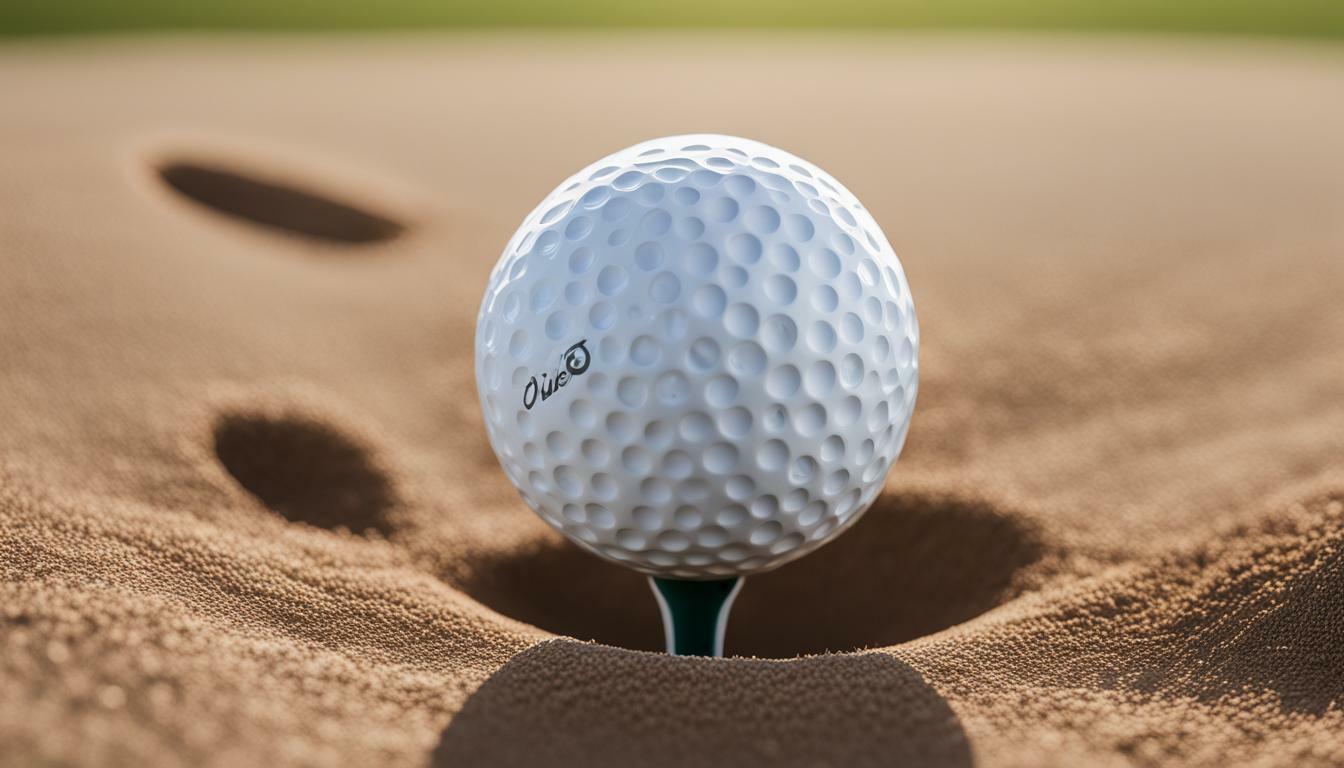If you’re an avid golfer or just starting out, you may have wondered about the number of divots on a golf ball. The pattern of dimples on the surface of a golf ball plays a crucial role in its aerodynamics and can affect your game.
Understanding the science behind the design of a golf ball can help you optimize your performance on the course.
In this article, we’ll explore the number of divots on a golf ball, the science behind their design, and how they influence your game. Whether you’re a beginner or pro, this information can help you improve your game and achieve better results.
Key Takeaways
- The number and pattern of dimples on a golf ball affect its aerodynamics and can impact your game.
- Understanding the science behind golf ball design can help you optimize your performance on the course.
The Golf Ball Surface and Divots
The surface of a golf ball can be smooth or have various patterns and designs. The purpose of these patterns is to create divots on the surface of the ball. A standard golf ball has dimples or small indentations on its surface. But how many divots are on a golf ball?
| Golf Ball Type | Number of Divots |
|---|---|
| Standard | 336 – 408 |
| Urethane | 324 – 360 |
| Surlyn | 332 |
The number of divots on a golf ball varies based on the type of ball and design. The design of the divots on the surface of the ball determines how the ball travels through the air, and ultimately how far it can go.
When a golf ball is struck with a clubface, the dimples on the surface of the ball create turbulence in the air around it. This turbulence reduces the drag on the ball, allowing it to travel a greater distance.
The Golf Ball Surface and Divots
“Whether the ball is smooth or has dimples, the surface of a golf ball is designed to create divots that allow for better aerodynamics and longer ball flights.”
The patterns and designs on the surface of a golf ball are not randomly placed. They are strategically designed and tested to create the best possible aerodynamics for the ball.
Scientists and engineers use wind tunnels and computer simulations to design golf ball patterns that maximize lift and reduce drag. The result is a ball that flies farther and more accurately than previous designs.
Through testing and experimentation, manufacturers have discovered the ideal number and shape of divots for each type of golf ball. They use this knowledge to create balls that provide the best possible performance for golfers of all levels.
The Science of Golf Ball Aerodynamics
When you hit a golf ball, it travels through the air with a specific trajectory that depends on a number of variables, such as the ball’s speed, spin, and air resistance it encounters. Understanding the science behind these factors can help you optimize your ball’s performance on the course.
In the case of golf ball aerodynamics, air resistance is a crucial factor. The golf ball is designed to minimize air resistance by creating a thin boundary layer of air that clings to its surface. This boundary layer reduces turbulence and drag, allowing the ball to move through the air more efficiently.
The dimples on the surface of a golf ball play a significant role in creating this boundary layer. Dimples disrupt the smooth flow of air around the ball, creating small eddies that mix high and low pressure air and promote the formation of the boundary layer. The more dimples a ball has, the better it can create this layer and reduce drag.
The size, pattern, and depth of the dimples also affect the ball’s aerodynamics. Golf ball manufacturers use computer modeling and wind tunnel testing to optimize the dimple design for maximum performance. Balls with shallow, wide dimples tend to produce a higher trajectory, while balls with deeper, narrower dimples fly lower and have a flatter trajectory.
Additionally, the number and placement of the dimples can affect the ball’s stability and spin. A ball with more dimples will have a more turbulent boundary layer, producing more spin and greater stability in flight. However, too many dimples can be counterproductive, causing the ball to become too turbulent and lose distance.
Overall, understanding the science of golf ball aerodynamics can help you choose the right ball for your playing style and optimize its performance on the course.
The Relationship Between Divots and Performance
Now that you know how many divots are on a golf ball and understand their purpose, let’s dive into how they impact performance.
When a golf ball is struck, the divots create turbulence in the air around the ball, which reduces drag and allows the ball to fly farther and straighter. This is why high-end golf balls have more and smaller divots, as they create more turbulence and optimize aerodynamics.
Additionally, the number and depth of the divots affect spin rate. More divots and deeper grooves create more spin, which allows for greater control and accuracy on approach shots. However, too much spin can also lead to reduced distance.
It’s important to note that the relationship between divots and performance is not the same for every golfer. Swing speed, angle of attack, and other factors can impact the optimal number and size of divots for each individual golfer.
Overall, finding the right balance of divots for your game is crucial for maximizing distance, accuracy, and control on the course.
Factors to Consider for Divot Optimization
When it comes to golf ball divots, it’s essential to consider certain factors to optimize your ball’s performance. Here are some of the things you should keep in mind:
- Golf Ball Design: The design and pattern on the golf ball’s surface play a crucial role in determining how many divots it should have. The design can affect the ball’s trajectory and spin, which can impact the distance and accuracy of your shots.
- Golf Ball Material: The material used to make the golf ball affects its weight, size, and aerodynamics. Different materials can lead to different numbers of divots, which can affect how the ball travels through the air and reacts on the green.
- Golfer’s Swing: Your swing speed and angle of attack can also influence the number of divots your golf ball should have. A golfer with a steeper swing may need fewer divots than someone with a shallower swing.
- Playing Conditions: The weather and course conditions can also play a role in the number of divots your ball should have. Windy or wet conditions may require more divots for better control and accuracy.
Optimizing Your Divots
“If you’re not sure where to start, experiment with different ball designs and materials to find what works best for your swing and playing style.”
To optimize your divots for better performance, it’s essential to find the right balance between the number of divots and other factors that affect your game. Here are some tips:
- Balancing Spin and Distance: If you’re looking for more distance off the tee, consider using a ball with fewer divots. However, if you want more control and spin around the greens, a ball with more divots may be better.
- Matching the Ball to Your Swing: As mentioned above, your swing speed and angle of attack can affect the number of divots your ball needs. Experiment with different designs and materials to find what works best for your swing and playing style.
- Considering Course Conditions: If you’re playing in windy or wet conditions, more divots may help you control your shots better. However, if the course is dry and firm, fewer divots may be sufficient for optimal performance.
By considering these factors and experimenting with different ball designs and materials, you can find the right number of divots for your golf ball and optimize your game for better distance, accuracy, and control.
Techniques to Create More or Fewer Divots
If you want to optimize your divots based on your playing style and preferences, there are several techniques you can try.
1. Adjust your swing
The number of divots on your golf ball depends on the amount of backspin generated by your swing. If you want more divots, try hitting the ball with a steeper swing and follow-through. If you want fewer divots, try hitting the ball with a shallower swing and follow-through.
2. Experiment with different types of golf balls
Not all golf balls are created equal. Some models have more divots than others due to the design of their surfaces. Experiment with different brands and models to find a ball that suits your playing style and preferences.
3. Try different golf club faces
The design and material of your golf club face can also affect the number of divots on your ball. For example, a club with a softer face may create more divots, while a club with a harder face may create fewer divots. Experiment with different clubs to find the best fit for your playing style.
4. Get a golf ball fitting
A golf ball fitting is a process in which a professional analyzes your swing and recommends a ball that is most suitable for your game. This can help you optimize your divots as well as your overall performance on the course.
The Conclusion
After reading this article, you now know how many divots are on a golf ball and what their purpose is. The surface of a golf ball is designed with specific patterns and divots to optimize its aerodynamics and enhance performance.
Understanding the science of golf ball aerodynamics and the relationship between divots and performance can help you make more informed decisions when choosing a golf ball. Additionally, factors such as swing speed, course conditions, and personal preferences should be considered when deciding on the number of divots on your golf ball.
If you want to create more or fewer divots on your golf ball, there are certain techniques you can use to achieve this. However, it’s important to note that altering the surface of the ball can affect its performance and potentially lead to disqualification in competition play.
Overall, the number of divots on a golf ball is just one aspect to consider when choosing a ball that fits your game. By understanding the science behind it, you can make informed decisions and ultimately improve your golf performance.





Leave a Reply